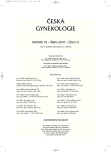Streptococci group B in perinatology
Authors:
K. Biringer 1; K. Biskupská Boďová 1; M. Haško 1; K. Dókuš 1; J. Danko 1; L. Štillová 2; Z. Biringerová 3
Authors‘ workplace:
Gynekologicko-pôrodnícka klinika JLF UK, Martin, Slovensko, prednosta prof. MUDr. J. Danko, CSc.
1; Neonatologická klinika JLF UK, Martin, Slovensko, prednosta prof. MUDr. M. Zibolen, CSc.
2; Klinika anesteziológie a intenzívnej medicíny JLF UK, Martin, Slovensko, prednosta doc. MUDr. B. Sániová, CSc.
3
Published in:
Ceska Gynekol 2010; 75(5): 435-438
Overview
Objective:
Assessment of screening and prophylaxis of streptococci group B (GBS).
Design:
Retrospective study.
Setting:
Department of Gynecology and Obstetrics, Jessenius Faculty of Medicine, Comenius University, Martin, Slovak Republic.
Methods:
Groups of patients: A–GBS negative (n=601), B–GBS positive (n=166), and C–unknown GBS status (n=238).
Results:
We assessed 1005 deliveries; antenatal screening was done in 767 patients (166 GBS positive). Intrapartal antibiotic prophylaxis (IAP) was the most frequent in group B (75.3%), (A–10.0%, C–15.0%). The most common antibiotics: ampicillin, and cephalosporins of the 1st and 2nd generation. The interval from rupture of membranes (ROM) to the first IAP dose was significantly the shortest in group B. The longest interval from ROM to delivery was in group A (490 min.).
Conclusion:
This study shows the possibilities for improvement in GBS prophylaxis, in unknown GBS status, and preterm delivery, particularly.
Key words:
streptococci, GBS, perinatology, sepsis, morbidity, mortality.
Sources
1. Anderson-Berry, AL., Bellig, LL., Ohning, BL. Neonatal Sepsis. Aug 18, 2006. Dostupný na WWW: http://www.emedicine. com/ped/topic2630.htm.
2. American College of Obstetricians and Gynecologists. Committee Opinion. Prevention of early-onset group B streptococcal disease in newborns. Obstet Gynecol, 2002, 100, p. 1405–1412.
3. Hansen, SM., Uldbjerg, N., Kilian, M., et al. Dynamics of Streptococcus agalactiae colonization in women during and after pregnancy and in their infants. J Clin Microbiol, 2004, 42, 1, p. 83–89.
4. Illuzzi, JL., Bracken, MB. Duration of intrapartum prophylaxis for neonatal group B streptococcal disease. A systematic review. Obstet Gynec, 2006, 108, p. 1254–1265.
5. Kind, C. Betreuung der Neugeborenen von Muttern, die mit Streptokokken der Gruppe B kolonisiert sind. Guidelines. Swiss society of neonatology, 2002. Dostupný na WWW: http://www. neonet.ch.
6. Macko, J., Zach, J. Postup péče o novorozence Streptococcus agalactiae negatívnich, pozitívnich nebo nevyšetřených matek. 2006. Doporučené postupy v neonatologii. Česká neonatologická společnost J. F. Purkyně. Dostupný na WWW: www.neoweb.cz.
7. Moore, MR., Schrag, SJ., Schuchat, A. Effects of intrapartum antimicrobial prophylaxis for prevention of group B streptococcal disease on the incidence and ecology of earlyonset neonatal sepsis. Lancet Infect Dis, 2003, 3, p. 201–213.
8. Narayanan, SK., Levy, CS. Streptococcus Group B Infections. Mar 24, 2006. Dostupný na WWW: http://www.emedicine.com/ med/topic2185.htm.
9. Puopolo, KM., Madoff, LC., Eichenwald, EC. Early-Onset Group B Streptococcal Disease in the Era of Maternal Screening. Pediatrics, 2005, 115, 5, p. 1240-1246.
Labels
Paediatric gynaecology Gynaecology and obstetrics Reproduction medicineArticle was published in
Czech Gynaecology

2010 Issue 5
Most read in this issue
- Laboratory and clinical indicators of the state of the newborn after birth
- Vacuumextraction
- Lesions of peripheral nerves in obstetrics and gynecology. A review
- The efficiency of oral contraception containing drospirenone in treating symptoms of premenstrual syndrome or premenstrual dysphoric disorder in gyneacology practice
